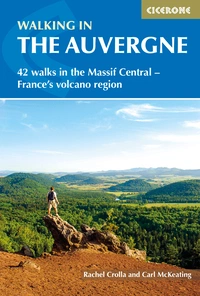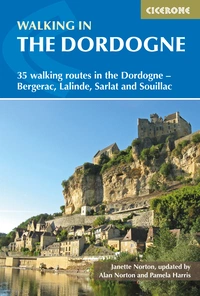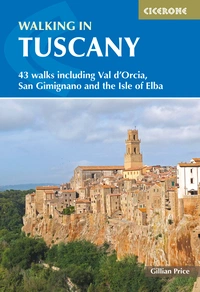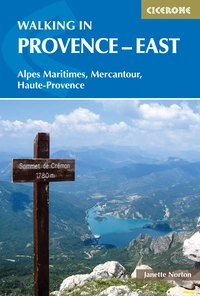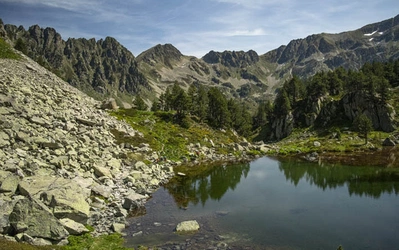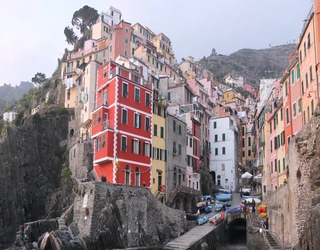Walking in the Auvergne – everything you need to know
The Auvergne forms the major part of the Massif Central of France. It's a stunning area of ancient volcanic scenery, crossed by numerous waymarked paths which thread through a landscape covering 25,000 square kilometres. It's easily accessible, the climate is not too extreme, the towns and villages offer historic interest and the walking opportunities range from gentle short walks to vigorous day-long mountain excursions. Here's everything you need to know.
| What? | 42 day walks in the Auvergne |
| The Auvergne? | The quiet volcanic hills of central France |
| Which areas are covered? | Five areas are covered: Cantal, Chaine des Puys, Mont Dores, Haute-Loire and Montagne Bourbonnaise. |
| How long are the routes? | Between 5 and 20km |
| How long do the walks take? | Most of the walks described will take between two and three hours, which is ideal for a morning before it gets too warm, or maybe a late afternoon ahead of a delicious meal of local cuisine and wine. |
| Are there any challenge routes? | Yes – each region also includes one or two longer or more challenging routes of over 12km which will take upwards of four hours, when you can reap the rewards of fine views and a more strenuous mountain day. |
| Which season is best for walking? | All the routes can be enjoyed from May to October. The summer months are usually hot and sunny, but the winters see snowbound villages and skiing on the higher Auvergne peaks |
| How do I get to the Auvergne? | The most convenient airport is Clermont-Ferrand, which can be reached direct by high speed train from Paris in 3hr 30min. Alternatively, taking your own car to France from the UK is simple. |
| What accommodation is available? | The wide variety of accommodation on offer in rural France can be baffling but can also be a highlight of your visit. Traditional hotels are found in larger towns, whereas smaller Auvergne villages generally have an auberge or ‘inn’. These often have plenty of character and tend to serve limited menus based on local produce. |
| How hard are the walks? | The walks in this Guide have been divided into three broad levels of difficulty, ranging from easy to challenging so there's something for everyone. |
| Are the routes waymarked? | Many sections of routes in this book are waymarked. |
| What maps do I need? | For all but the Grade 1 walks in this guide a map is recommended. Maps will serve the hiker well in the Cantal, Châine des Puys and Monts Dore especially. Detailed topographical maps are available for all the areas covered. |
| What are the area's highlights? | Fascinating volcanoes: Puy de Dôme, de la Vache and Pariou; high summits: Plomb du Cantal, Puy Mary and Puy de Sancy; magnificent abbeys and churches: Chaise Dieu, Lavaudieu and Orcival; chateaux: Montgilbert and Lavoûte-sur-Loire; attractive bases: Le Puy-en-Velay and Vichy; lakes Guery and Pavin, the Grand Cascade and Volvic spring. |
Highlights of each area of the Auvergne
Cantal
The superb Cantal range would be the first port of call for those seeking high mountain adventure. The compact geography of the massif – formed by one supervolcano – would lend itself to an energetic week exploring its major summits. Murat is a small medieval town with good facilities which acts as a gateway to the mountains and makes a sensible base for exploring the region.
Châine des Puys (Monts Dômes) and Monts Dore
Rivalling the Cantal for its unique landscape and scarred by intense volcanic activity are the Châine des Puys and Monts Dore ranges. These are two separate mini areas but run into each other. Châine des Puys is perfect for shorter hill walks as there are no real elongated ridges and multi-peak link ups. The Monts Dore centre on the Massif de Sancy (at 1885m the highest peak in the Auvergne) and lend themselves to mountainous circuits. The large village of Orcival has many good restaurant choices and is ideally situated between the two mini-ranges of the Châine des Puys and the Monts Dore. All the walks in both sections can quickly be accessed from it by car.
Haute-Loire
The Haute-Loire is a vast area but the walks in the guidebook concentrate on the southern part of the department and focus on the historic area of the Velay and exploring the Parc de Livradois Forez. Allegre is a small but pleasant base, while in Le Puy-en-Velay there are innumerable Chain and independent hotel options, reflecting its importance as a pilgrimage centre.
Montagne Bourbonnaise
Montagne Bourbonnaise is a compact and beautiful unspoilt walking area. Mayet de Montagne is a good base which offers a decent range of accommodation and facilities including a supermarket, while another good choice for a base is the quaint village of Ferrieres sur Sichon.
Walking in the Auvergne
42 Walks in the Massif Central - France's volcano region
£14.95
Guidebook to the Auvergne describing 42 walks between 5 and 20km in the quiet volcanic hills of central France. Five areas are covered: Cantal, Chaine des Puys, Mont Dores, Haute-Loire and Montagne Bourbonnaise. The volcanic geography provides a stunning backdrop to routes suitable for all walkers. Bases in Vichy, Clermont-Ferrand and Puy-en-Velay.
More information
